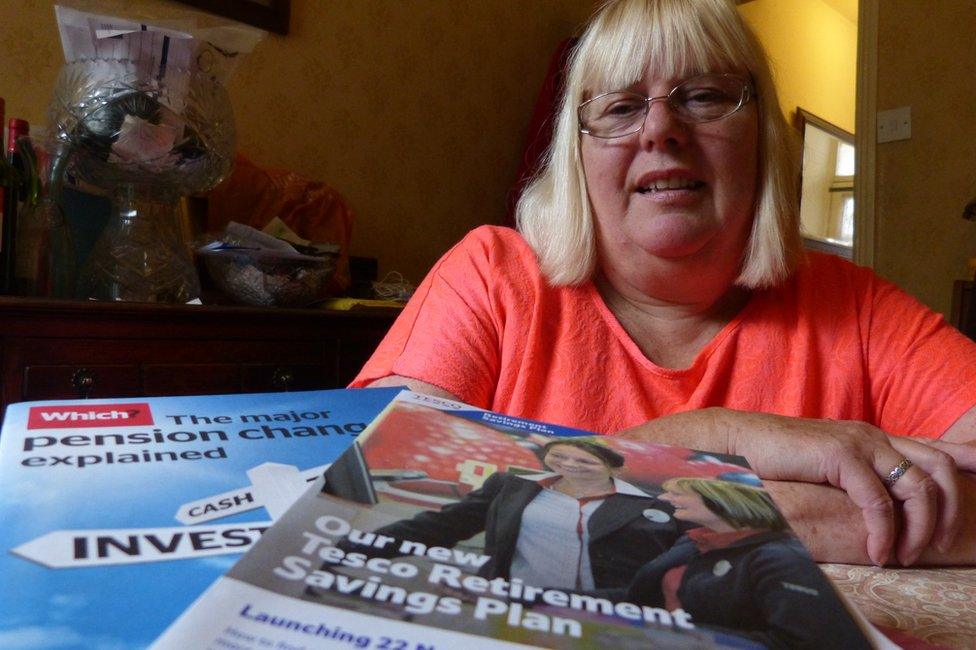How to be a mum and still get a decent pension
- Published

Those who give up work to look after a family - whether they be male or female - are amongst those least likely to save for retirement.
"Stay-at-home mums are at the highest risk," says Kalpana Fitzpatrick, founder of the website MummyMoneyMatters.com.
"Saving for retirement is simply not on the agenda, because they have no income."
So if you are a full-time parent, ask yourself this: Could I survive on an annual income of £8,000 in retirement?
That is roughly what the state pension currently pays out, if you have 35 years of National Insurance (NI) credits.
But if the answer to the above is "no", there are some practical things you can do to maximise any savings, however small they may be.

Working Mother: Lesley Osborn, 58

Lesley Osborn, from Purley in Surrey, began work as an apprentice printer at the age of 16.
But with four children from two marriages, she has had over ten years as a stay-at-home mum.
"It's really hard to save for a pension," she says. "When you've got kids, you're focused on your kids."
She now works part-time as a cashier in Tesco, and has built up a personal pension worth £1500 a year.
"That's not much, is it?" she says. She now wishes she had started saving earlier.
"Hindsight: Isn't it a wonderful thing? But it's too late for me."
To give themselves a retirement income, she and her husband are planning to sell their house, and move to something smaller.

Top tips

First, it is worth remembering that even though you are away from the workplace, your years as a parent still qualify towards your state pension.
As long as you are registered for child benefit, and your youngest child is under 12, you will get National Insurance (NI) credits for the time at home.
But to qualify for the full state pension, you will still need to have 35 years NI credits in total by the time you retire. With less than 10 years of credits, you will get nothing at all.
Second, if you are in a workplace pension scheme, experts suggest you should try and stay in it.
In any case your employer will continue to make contributions into your fund for the duration of your maternity leave.
That will be for at least 39 weeks, and in some cases more.
If your workplace scheme is a group personal pension, you might also be able to continue making contributions into it, if you can afford to do so. Your employer will continue making contributions too.

Lifetime ISA
If you are no longer earning, and you are not part of a company scheme, you have two options:
You could open a private personal pension
or
You could open a Lifetime ISA (Lisa) in 2017 - if you are under 40 on 6 April.
"For those who don't have access to support from an employer, we think the Lifetime ISA offers a much better return than saving in a pension," says Richard Parkin, head of retirement at Fidelity International.
On the face of it both options appear to offer the same bonus.
All basic rate taxpayers have their contributions into a pension boosted by 25%, the same top-up offered by the Lisa.
But the key difference is that money saved into a pension will be taxed when it is taken out - whereas cash put into a Lisa will not be.
So someone putting £800 into a pension will have it topped up to £1000. After basic rate tax on its withdrawal they will be left with £850 - a 6% gain, aside from any interest earned.
By contrast, £800 put into a Lisa will - after the government top-up - automatically grow to £1000 - a 25% return (see table below).
Read more about: The Lifetime ISA

Nappies
If, as a parent, you give up work, it has been suggested that your working partner might like to pay you a pension.
"I think it's absolutely fair to ask a partner to contribute to a pension," says Kalpana Fitzpatrick.
"There are people who do it, and some partners would be very open to it."
But Lesley Osborn, is sceptical, as she says her husband, a furniture upholsterer, could never afford it.
Instead she prefers the idea of compulsory saving into a pension from a young age.
And better information for parents-to-be.
"When women pack up work, they're given leaflets on how to change nappies. Maybe there should be the odd leaflet on pensions too."

Pension Calculators

State pension calculator DWP, external
Combined state, workplace and DC calculator, from Standard Life, external
Should I delay buying an annuity? Hargreaves Lansdown , external
How much can I earn from a DC pot? Money Advice Service, external
How much tax will I pay on a lump sum withdrawal? Scottish Widows, external

Lost pensions
Over a lifetime of work it is easy to lose track of workplace pensions - especially if you have had many part-time jobs, as mothers tend to do.
On average, people work for 11 different employers over their lives. As a result, as much as £400m has been "lost" in pension pots which people have forgotten about.
The new pension dashboard, currently being developed, will help with that, as it will enable workers to keep track of different pensions, and how much they're worth. In the meantime, you can consult The Pensions Tracing Service, external.

Top-ups
Anyone who has not qualified for the full state pension should also consider topping up their national insurance contributions.
Richard Parkin says pension top-ups, external offer very good value.
"When you're topping up you're buying an inflation-linked pension, and that costs an absolute fortune to buy from an insurance company."
Otherwise his advice is simply to save as much as you can, as early as you can.
"The more you put in, and the sooner you put it in, the less you'll need overall," he says.
"It is always worth it, because otherwise you're not going to have anything to live on in retirement."